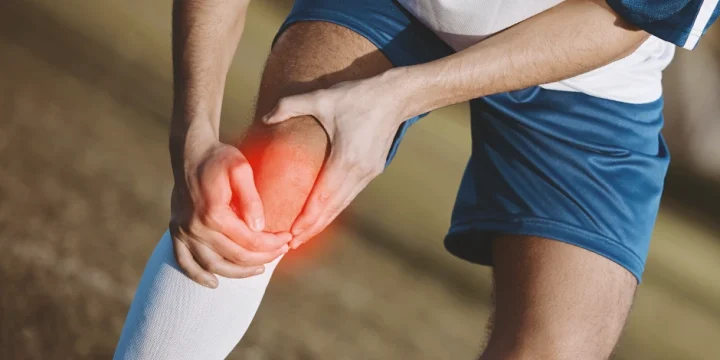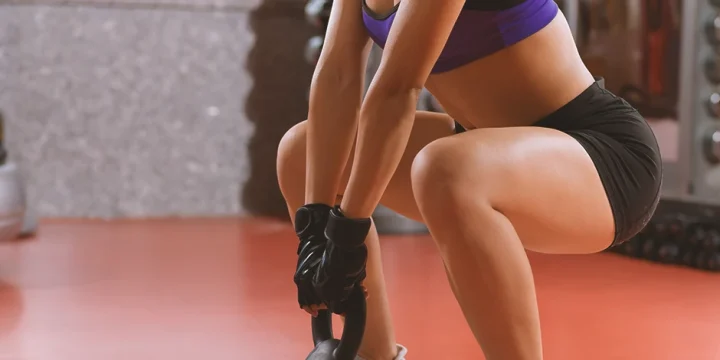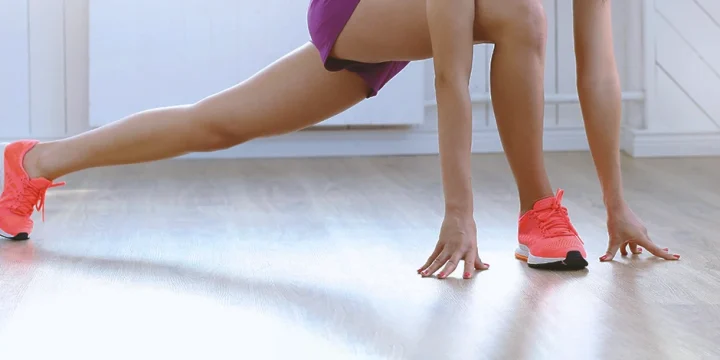Quick Summary
- The best yoga poses include the cobra pose, half spinal twists, crescent lunge twist, bow pose, child’s pose, reclined twist, plow pose, and gas release pose.
- Yoga postures contribute to relieving constipation through various mechanisms. They enhance blood circulation and supply oxygen to the abdominal muscles, alleviate stress, provide gentle massages to the abdomen, and encourage proper peristalsis.
- Hindawi's studies on individuals with irritable bowel syndrome (IBS) suggest yoga as a cost-effective method to manage symptoms like constipation and diarrhea.
- Having seen the positive effects of the Cobra and Child's Pose on my clients, I am convinced of their effectiveness in promoting digestive health.
8 Yoga Poses for Constipation Relief

Below are some of the best yoga poses to relieve constipation based on my experience with clients.
1. Bhujangasana (Cobra Pose)
How to do this exercise
- Lay in a prone position (face down on the ground). Place your hands by your chest, with your elbow hugging your body.
- Engage your chest muscles and use their strength to lift your upper body off the ground. Continue lifting your upper body until your navel is off the ground.
- Pause at the top position for six seconds.
- Slowly lower your body back to its initial position.
- Repeat for a total of six reps.
2. Ardha Matsyendrasana (Half Spinal Twist)
How to do this exercise:
- Sit on a yoga mat with your buttocks resting on your heels (Vajrasana, or diamond pose).
- Lift your hips slightly and shift your weight to the left side, allowing your buttocks to touch the mat.
- Place your right foot across your left knee, ensuring your hips remain on the mat.
- Place your right hand behind you for support.
- Lift your left arm towards the ceiling, twist your torso, and bring your hand to the outside of your right foot. As you twist, gently turn your head to look over your right shoulder.
- If you cannot reach your foot, bend your elbow and rest it on your shoulder, using your upper arm to gently push the knee back.
- Pause while making sure there is no tension on the shoulder.
- Return to the starting position and repeat on the opposite side.
3. Balasana (Child’s Pose)
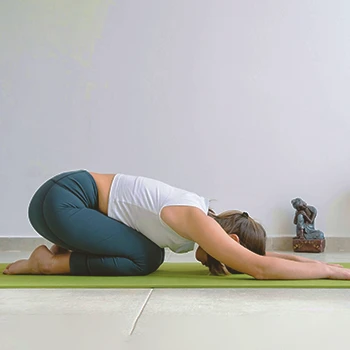
How to do this forward bending pose:
- Get into a Vajrasana pose, sitting on your heels with your knees bent and feet touching the ground.
- Slowly transition into a table pose, aligning your wrists directly under your shoulders. Keep your knees hip-width apart.
- Extend your arms in front of you, placing your palms on the floor.
- Lower your hips toward your heels. Your knees can be together or slightly apart, depending on what feels best for your body.
- Rest your forehead on the floor, allowing your neck and shoulders to relax.
- Hold this position for fifteen to thirty seconds.
“Because your stomach can be compressed somewhat in this position, it's better to do this pose at least an hour after eating.”
- Ann Pizer, Yoga Instructor
4. Parivrtta Anjaneyasana (Crescent Lunge Twist)
How to do this exercise:
- Come into a runner’s lunge position with your left leg extended back and right leg forward. Make sure your feet are hip-width apart.
- Bend your back leg slightly, allowing a gentle bend at the knee. Rest your hands on the front knee.
- Activate your abdominal muscles and lift your torso.
- Straighten your back leg.
- Bring your hands together in a prayer position and place your right elbow outside your front thigh. Keep your chest lifted and your shoulders back.
- Press your left palm against your right palm, using it as resistance to deepen the twist.
- Hold for fifteen to thirty seconds and repeat on the opposite side.
5. Dhanurasana (Bow Pose)
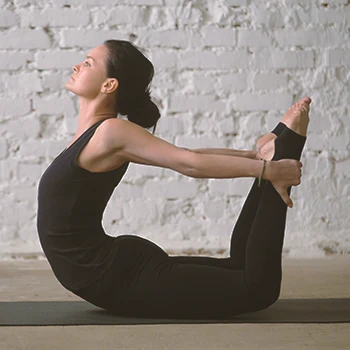
How to perform this exercise:
- Lay on your stomach in a prone position, ensuring your legs and feet are together.
- Flex your knees and extend your arms backward to grasp your ankles.
- As you inhale, slowly lift your thighs, chest, and head off the ground, arching your back.
- Exhale slowly and bring your heels close to your buttocks, maintaining a comfortable stretch. Keep your balance on your stomach.
- Hold for six seconds while taking deep breaths.
- Exhale as you return to the starting position.
“When you reach back with your hands, grab your ankles and not any other part of the foot.”
- Lacey Muinos, Fitness Writer
6. Supta Matsyendrasana (Reclined Twist)
How to do this exercise:
- Lay on your back on a mat with your arms stretched out to the sides at shoulder level.
- Bend your right knee and cross it outside your left leg, positioning it close to your left knee.
- Slowly initiate the twist by gently lowering both knees towards the left side of your body. Use your right hand to apply slight pressure on the bent right knee.
- Press down the right knee towards the floor. Focus on keeping your shoulders squared and rooted to the ground.
- Hold for ten to fifteen seconds while breathing deeply.
- Slowly bring your knees back to the center, extend your legs to release the pose, and repeat on the other side.
7. Halasana (Plow Pose)
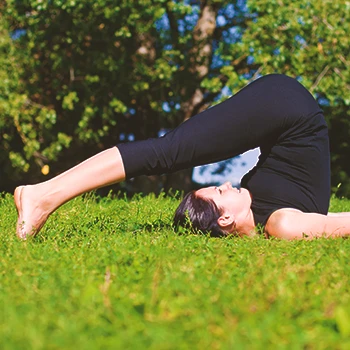
How to perform this exercise:
- Lie on a mat with your legs extended straight out in front of you and your palms resting on the ground by your sides.
- Lift your hips off the ground, using your core strength to support the movement. Simultaneously, lift your legs over your head until they touch the floor behind you.
- You can place your hands on your lower back for added support.
- Hold for about ten seconds while taking deep, slow breaths.
- Press your hands firmly onto the floor and slowly unroll your spine to release the position.
“These poses massage your digestive organs, increase blood flow and oxygen delivery, aid the process of peristalsis, and encourage stools to move through your system. Doing yoga regularly can result in regular, healthy bowel movements.”
- Rachael Weiss, Yoga Instructor
8. Pawanmuktasana (Gas Release Pose)
How to do this exercise:
- Lie on your back on a mat with your legs extended straight out in front of you and your palms resting on the ground by your sides.
- Fold your legs and draw your knees in towards your chest. Use your hands to wrap your arms around your legs.
- Bend your neck forward, bringing your knees as close as possible to your forehead.
- Maintain this posture for ten to fifteen seconds.
- Lower your head and legs back to the mat to release the pose.
Incorporating yoga with a diet high in fiber-rich foods such as whole grains, fruits, and vegetables boosts digestive health.
This combination not only complements yoga's physical advantages but also softens stool and enhances bowel regularity.
In my experience as a personal trainer, clients who adopt this holistic approach often report significant improvements in their digestive well-being.
How Can Yoga Help With Constipation?

Yoga aids constipation relief by enhancing stool movement in the digestive system, mainly through twisting poses, inversions, and forward folds.
These postures actively stimulate digestive organs, boost circulation, and ensure ample oxygen reaches the abdomen.
Yoga also effectively eases dyspepsia symptoms like bloating, burning sensations, and feeling too full post-meal.
The Journal of Ayurveda and Integrative Medicine's research highlights yoga's role in improving appetite and reducing regurgitation [1].
Research by Hindawi on individuals diagnosed with irritable bowel syndrome (IBS) discovered that yoga might offer a cost-effective alternative to managing the main symptoms associated with the condition, such as constipation and diarrhea [2].
By activating the parasympathetic nervous system, yoga promotes healthy digestive tract movement and helps manage stress, according to the National Institutes of Health [3,4].
From my experience as a personal trainer, clients who incorporate yoga often report a notable improvement in their digestive health and stress levels, further supporting these findings.
While yoga can help reduce the symptoms of constipation, a person should see a medical expert if they experience:
- Changes in bowel habits
- Intense abdominal pain
- Unintentional weight loss
- Persistent constipation even after exercising and increasing fiber consumption
Related: Does Yoga Burn Fat
FAQs
Can Yoga Help With Constipation?
Yes, yoga can help with constipation by putting pressure on the abdomen, stimulating digestive organs, promoting oxygen supply to your abdominals, and reducing stress.
What is the Best Position to Stimulate Bowel Movement?
The best position to stimulate bowel movement is twisting poses, which can promote blood circulation and release tension. Other positions that may help facilitate bowel movement are inversions and forward folds.
References:
- https://www.sciencedirect.com/science/article/pii/S0975947623000311?via%3Dihub
- https://www.ncbi.nlm.nih.gov/pmc/articles/PMC4438173/
- https://www.ncbi.nlm.nih.gov/pmc/articles/PMC5808284/
- https://www.ncbi.nlm.nih.gov/pmc/articles/PMC5859128/
About The Author
You May Also Like
